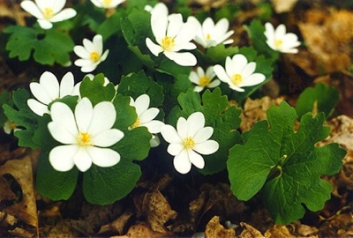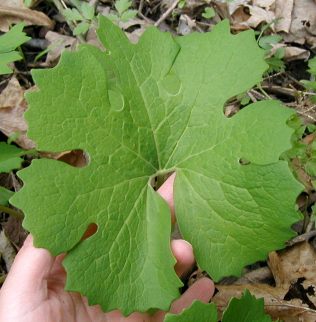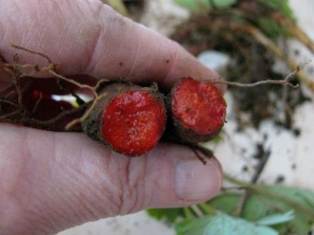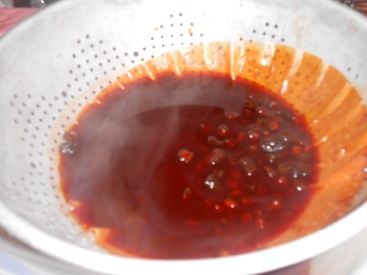General Information:
Bloodroot is considered a native plant in central North America, hardiness zones 3-8. Other common names include Indian Paint and Sweet Slumber. The plant prefers partial to full shade, and is commonly found in rich forests near streams. Bloodroot is a perennial, part of the Papaveraceae (Poppy) family. In the spring, bloodroot has a showy white flower, approximately 2” in diameter. After blooming, the plant’s light green leaves grow to form a plant approximately 8-14” tall. Bloodroot is easy to identify due to the roots and stem, which when cut ooze a red/orange liquid, hence the name “bloodroot”.

Bloodroot Spring Flowers

Unique bloodroot leaf, grows up to 8″ in size after flowers have dropped

Bloodroot rhizomes
Traditional Uses:
Native American tribes commonly used bloodroot for dyeing cloth and skin. The root or the whole plant may be used, depending on the purposes. For preservation, it is best collected in the fall, and then dried into a powder to be used in the future. For topical remedies, the liquid works best applied directly to skin conditions. Bloodroot is an emmenagogue (promotes menstruation), and an expectorant (expels mucus). Common medicinal uses include treatments for: asthma, bronchitis, croup, pulmonary consumption, nervous irritation, high pulse, heart weakness, dental hygiene, and ringworm. Some sites claim bloodroot as an anti-cancer agent. Bloodroot is most often used to treat chronic bronchitis and chronic eczema. When using bloodroot, one must be cautious of the dosage level; if administered in too high of doses it can cause burning in the stomach, intense thirst, vomiting, vertigo, dim eyesight, and/or death.

Bloodroot liquid being formed into dye
Current Research:
There has been much research concerning bloodroot and its most common alkaloid sanguinarine. Sanguinarine is the active chemical found in bloodroot and results in the medicinal effects as listed above. Bloodroot contains eight different alkaloids, but sanguinarine is the most common and contains the highest potency. Sanguinarine has been connected with cell death similar to treatments of chemotherapy. When the alkaloid binds with DNA polymerase, it causes the DNA strands to break and the cell to die. Sanguinarine also binds with nuclear poisomerase, which is the same target as chemotherapy drugs. Additional research is necessary to determine the anti-cancer capabilities of bloodroot.
Several case studies concerning topical remedies have led physicians to be skeptical of the positive effects of bloodroot on skin conditions. In these case studies, patients applied a bloodroot salve to a skin condition, resulting in damage and scarring to the area. Scarring occurred after only one or two applications, and so dosage was not an issue. Therefore, if using bloodroot, it is important to with caution, and highly recommended to consult a physician before applications.
*Bloodroot is becoming a popular “fad” to be used for topical skin conditions. It is important to research this plant in depth before self-medicating.
Citations:
http://www.botanical.com/botanical/mgmh/b/bloodr59.html
https://www.drugs.com/npc/bloodroot.html
https://altnature.com/gallery/bloodroot.htm
https://plants.usda.gov/core/profile?symbol=saca13
http://www.herbalremediesadvice.org/herbal-energetics.html
http://www.missouribotanicalgarden.org/PlantFinder/PlantFinderDetails.aspx?kempercode=m290
http://www.mdedge.com/cutis/article/100300/contact-dermatitis/black-salve-and-bloodroot-extract-dermatologic-conditions
https://www.ncbi.nlm.nih.gov/pubmed/25046467
https://www.ncbi.nlm.nih.gov/pubmed/27618894
https://www.ncbi.nlm.nih.gov/pubmed/28088021
Picture Links:
https://sites.google.com/a/d.umn.edu/umdsapmpg/_/rsrc/1335550124036/plant-profiles/blood-root/bloodroot.png?height=270&width=400
http://wildeherb.com/wp-content/uploads/2010/04/bloodroot-leaf1.jpg
http://crystalbridges.org/wp-content/uploads/2015/11/Bloody-blood-root.jpg
http://slowyarn.com/wp-content/uploads/2014/04/bloodroot-dye-in-colander.jpg
Page created by Jenny Walz